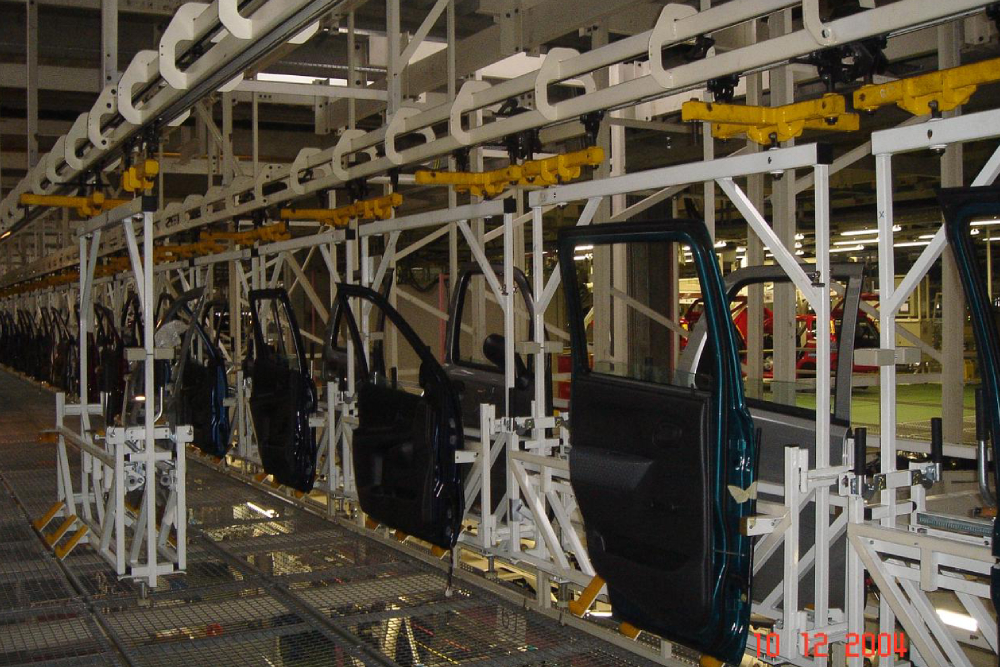

If you’ve ever wondered how massive manufacturing plants manage the complex task of moving parts seamlessly from one process to another, the answer often lies in power and free conveyors. These innovative systems are the backbone of modern assembly lines, offering unmatched flexibility and efficiency. Let’s dive into what makes them so special.
What are Power and Free Conveyors?
Basic Definition
At their core, power and free conveyors are a type of overhead conveyor system. They are designed to transport parts along a predetermined path, allowing for sophisticated routing options and the ability to stop and start as needed. This flexibility is what sets them apart from traditional conveyor systems.
Key Components
These conveyors consist of two main tracks: one powered and one free. The powered track moves continuously, while the free track allows carriers to stop and wait until they are needed. This dual-track system provides the ability to control the flow of materials with precision.
How Do Power and Free Conveyors Work?
Mechanism Explained
The powered track uses a continuous chain to move carriers along the conveyor path. Each carrier can be engaged or disengaged from the powered track, allowing it to move or stop independently. This mechanism enables the system to handle complex routing and variable speeds efficiently.
Flow of Parts
Parts are loaded onto carriers that travel along the free track until they reach a point where they need to merge onto the powered track. At this point, they can be moved quickly to the next stage of the assembly process. This system ensures that parts arrive exactly when and where they are needed, optimizing the workflow.
Advantages of Power and Free Conveyors
Flexibility in Routing
One of the standout benefits of power and free conveyors is their ability to handle complex routing. They can easily accommodate changes in the production process, making them ideal for dynamic manufacturing environments.
Variable Speeds
The ability to vary speeds is another significant advantage. This feature allows manufacturers to optimize the movement of parts through different stages of production, reducing bottlenecks and increasing efficiency.
Load Management
These conveyors can handle a wide range of loads, from lightweight components to heavy parts. This versatility makes them suitable for various industries, including automotive, electronics, and general manufacturing.
Applications in Assembly Lines
Automotive Industry
In the automotive industry, power and free conveyors are used to move car parts through various stages of assembly, from welding to painting to final inspection. Their ability to handle heavy loads and complex routing makes them indispensable in this sector.
Electronics Manufacturing
For electronics manufacturing, these conveyors provide the precision needed to move delicate components through the assembly process without damage. They also help in maintaining a clean and organized production environment.
General Manufacturing
In general manufacturing, power and free conveyors offer the flexibility to handle a variety of products and processes. Whether it’s moving heavy machinery parts or lightweight consumer goods, these systems ensure efficient and reliable transportation.
Design Considerations
Space Requirements
When designing a power and free conveyor system, space is a critical factor. These systems require overhead space for the tracks and sufficient room for the carriers to move freely. Proper planning is essential to ensure optimal layout and operation.
Customisation Options
Customisation is key to maximising the benefits of power and free conveyors. From track layout to carrier design, these systems can be tailored to meet the specific needs of any production line. This flexibility makes them a valuable investment for any manufacturing facility.
Installation and Maintenance
Initial Setup
Installing a power and free conveyor system involves careful planning and precise execution. The tracks must be securely mounted, and the carriers must be properly aligned to ensure smooth operation. Professional installation is recommended to avoid issues down the line.
Routine Maintenance
Like any machinery, these conveyors require regular maintenance to keep them running smoothly. Routine checks and timely repairs can prevent breakdowns and extend the lifespan of the system, ensuring a good return on investment.
Cost Analysis
Initial Investment
The upfront cost of a power and free conveyor system can be significant, but it’s important to consider the long-term benefits. These systems can improve efficiency and reduce labor costs, making them a worthwhile investment for many manufacturers.
Long-term Savings
Over time, the efficiency gains and reduced downtime provided by power and free conveyors can lead to substantial savings. By optimizing the production process, these systems help manufacturers save money and increase profitability.
Conclusion
Power and free conveyors offer unparalleled flexibility and efficiency for assembly lines. Their ability to handle complex routing, variable speeds, and diverse loads makes them an invaluable asset for modern manufacturing. By investing in these systems, manufacturers can optimise their production processes and stay competitive in an ever-evolving market.
ALSO READ
Power and Free Overhead Conveyor Systems vs Traditional Conveyor Systems


